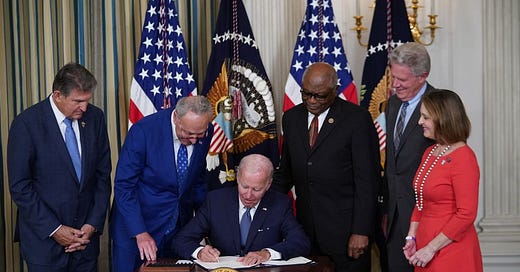President Biden signs the misnamed Inflation Reducation Act last year
The transition to a low carbon economy is proving to be a slow and frustrating process – and probably too gradual to avert the risks of serious climate disruption. But could a game changing move by the United States transform the energy market and take the heat out of the climate debate?
In 1997 as the first major international conference on climate change met in Kyoto the mix of global energy consumption was dominated by oil – which provided 39% of the total, coal with 25% and natural gas with 21%.
In 2022 on the latest available estimates the comparable percentages were oil 31%, coal 26% and natural gas 24%.
Hydrocarbons, the main source of carbon emissions, still account for over 80% of total energy use – with the absolute numbers increasing in line with growing demand. Even countries which have reduced emissions substantially – such as Germany and the UK - continue to rely on oil and gas (and in Germany’s case coal) for more than three quarters of their energy needs.
Unsurprisingly the increased use of fossil fuels has produced a continuing growth in CO2 emissions - up to 36.8 Giga Tonnes (GT) last year on the latest estimates and now more than 50 per cent higher than in 1997. The figures for 2022 show emissions back at pre Covid levels after a temporary dip.
For climate campaigners these numbers can only be a source of disappointment, even of despair. Tens of millions of words and dollars have produced only limited progress. Renewables – solar and wind power - have grown and thanks, in the main, to industrialised production of panels and turbines in China, have fallen in cost to the point where they are competitive with fossil fuels even in the absence of a carbon price. According to the International Renewable Energy Association wind and solar accounted for 83% of new power generating capacity last year. Capacity is not the same as production but the growth is still impressive. Without this shift and a continuing gradual improvement in energy efficiency the current level of emissions would be significantly higher.
The positive elements, however, have not produced a transformation of the overall picture. Population growth (almost a quarter of a million new global citizens are born each day) and the gradual spread of prosperity both continue to add to demand. SUVs are now best-selling vehicles in India and China as well as in Chelsea and account for almost half of all new car sales across the world. The dramatic expansion of airline travel, especially in Asia, has resumed as the lockdowns in China and elsewhere have been lifted.
Keep reading with a 7-day free trial
Subscribe to Comment is Freed to keep reading this post and get 7 days of free access to the full post archives.






